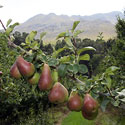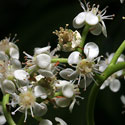|
Family:
Rosaceae (Rose, Peach, Apple, Pear, Loquat, Strawberry family) Life
> eukaryotes >
Archaeoplastida >
Chloroplastida
>
Charophyta > Streptophytina > Plantae (land plants)
> Tracheophyta (vascular plants) > Euphyllophyta > Lignophyta (woody plants)
> Spermatophyta (seed plants) > Angiospermae (flowering
plants) > Eudicotyledons > Order: Rosales
There are about 90 genera and 2520 species worldwide, mostly
found in the temperate regions of the northern hemisphere. There are eight genera
and 165 species native to southern Africa, an additional nine genera and 23
species naturalised, and an additional 28 genera and 183 species that are
cultivated in the region.
Genera native to southern Africa
List from Jordaan (2000).
Acaena
About 100 species worldwide,
found mainly in the cold regions of the southern Hemisphere. Acaena
latebrosa is the only species native to southern Africa, found in the
Western Cape. Two additional species, Acaena novae-zelandiae
(Bidi-bidi) from New Zealand and Acaena ovina (Australian sheep's
burr) from eastern Australia, are cultivated in southern Africa.
|
|
Agrimonia
About 15 species worldwide, of
which two are native to southern Africa. A further two species are cultivated in southern Africa.
|
 |
Alchemilla
About 250 species worldwide,
of which 16 are native to southern Africa, mainly in the eastern
summer-rainfall regions. A further two species from Europe, are cultivated
in southern Africa.
|
 |
Cliffortia
A total of 135 species, all native to southern Africa, with
two extending into tropical Africa.
|
 |
Geum
About 40 species worldwide, mainly
in temperate and cold areas of the northern hemisphere. The only species
native to southern Africa is Geum capense.
A further three species from
north temperate regions are cultivated in southern Africa.
|
 |
Leucosidea
The only species is Oldwood
Leucosidea sericea, found in the eastern half of South Africa, mainly along stream
banks at high altitudes.
|
 |
Prunus (almond, apricot, cherry, nectarine,
peach and plum genus) About 200 species, found mainly in
the northern hemisphere. Prunus
africana is the only species native to southern Africa and an
additional two species are naturalised and 23 species and at least three hybrids are cultivated in the region
including important commercial crops such as almonds, apricots, cherries, nectarines,
peaches and plums.
|

|
Rubus (blackberry, loganberry and rasberry
genus) About 250 species, found worldwide but mainly in the
temperate regions of the northern hemisphere. Species discrimination can be
difficult in Rubus because of the extensive natural and artificial
hybridization that has occurred. There are about eight species native to
southern Africa, and nine species and one hybrid that are naturalised to the
region. Since earliest times, people have collected berries
from species of Rubus.
|
 |
Genera naturalised in southern Africa
List from Jordaan (2000).
Cotoneaster
About 70 species worldwide, found mainly in the north
temperate regions of Europe and Asia, especially China. Cotoneaster franchetii and C. pannosus
have become naturalised in Gauteng, Free State, KwaZulu-Natal and
Eastern Cape and are declared
Category 3 invader plants in South Africa. An additional 38 species
and one hybrid are cultivated as garden ornamental plants in southern
Africa.
|
 |
Crataegus (Hawthorn genus)
About 1080 species, found in the northern hemisphere. Crataegus x
lavallei and C. monogyna have become naturalised in the Free
State and Eastern Cape. A further six species and one hybrid are cultivated
as garden ornamental plants in southern Africa.
|
|
Cydonia (Quince) The only species is
the Quince Cydonia oblonga which
is native to Causasia and northern Iran. It has become naturalised in the
Free State.
|

|
Duchesnea
(Indian Strawberry genus) The
six species are native to
the Indo-Malayan region, China and Japan. The Indian Strawberry
Duchesnea
indica has become naturalised in southern Africa.
|

|
Fragaria (Strawberries) About
12 species worldwide. The Wild Strawberry Fragaria vesca is sometimes
found naturalised in southern Africa. Strawberries Fragaria ananassa
are cultivated widely.
|
 |
Pyracantha
(Firethorn genus) About nine species, native to SE Europe, Caucasus,
NW Iran and China. Grown in gardens for their attractive, non-edible
berries. Three species have become naturalised in southern Africa and a
further four species are cultivated in the region.
|
 |
Pyrus (Pear genus)
About 30 species, native to Europe, North Africa and Asia.
Pyrus communis (Pear, Common pear)
is cultivated for its fruit, especially in the Western Cape where it has
also become naturalised. An additional five species and one hybrid are
cultivated in southern Africa.
|
 |
Rosa (roses)
There are about 100 to 150 species of rose and a huge number of hybrids and
cultivars. Native mainly to Asia but also Europe, North America and North
Africa. One species and one hybrid have become naturalised in southern
Africa and an additional 23 species and at least four hybrids are cultivated
in the region.
|
 |
Sanguisorba
About 10 species worldwide,
found mainly in the temperate regions of the northern hemisphere.
Sanguisorba
minor (Salad burnet), which is native to Eurasia and north Africa, is
cultivated in southern Africa and has also become naturalised in this
region.
|
|
Other genera, cultivated in southern Africa
List from Glen (2002). The species name is provided in
genera that have only one species represented in southern Africa. Quillaja saponaria
is now placed in the Quillajaceae.
|
Amelanchier (Shadbush
genus)
About 20 species, native to north temperate regions; four
species are cultivated in southern Africa. |
|
|
Aronia arbutifolia (Red chokeberry)
Native to the USA. This species, and the Black
chokeberry Aronia melanocarpa, have small violet-black fruit that are
harvested to produce Aronia berry juice. These fruit are also used for
making jellies and jams. In southern Africa, the Red chokeberry is grown
mainly as a garden plant.
See Wikipedia
page on this genus and species. |
|
|
Aruncus dioicus (Goat's beard)
Native to north temperate regions.
See
Wikipedia page on this species. |
|
|
Chaenomeles
Three species, native to east Asia, all cultivated as
garden plants in southern Africa. |
 |
|
Cowania stansburiana
Native to western USA and Mexico. |
|
|
+ Crataegomespilus dardarii (Bronvaux medlar)
An intergeneric hybrid, derived from Mespilus and
Crataegus. |
|
Eriobotrya
japonica
(Loquat) |

|
|
Exochorda
Four species, native to China and central Asia; three
species are cultivated in southern Africa. |
|
|
Fallugia paradoxa
Native to southern USA and Mexico.
See
Wikipedia page on this species. |
|
|
Filipendula vulgaris (Dropwort)
Indigenous from Europe through to Siberia.
See
Wikipedia page on this species. |
|
|
Hagenia abyssinica (African redwood, Brayera,
Cusso, Hagenia, Kousso)
Native to tropical East Africa.
See Wikipedia page on this species. |
|
|
Horkelia frondosa
Native to California.
See
Wikipedia page on the genus. |
|
|
Ivesia gordonii (Gordon's mousetail)
Native to western USA.
See
Wikipedia page on this species. |
|
|
Kerria japonica
Native to China, Japan and Korea.
See
Wikipedia page on this species. |
|
|
Malus (apples)
About 30-35 species, native to north temperate regions;
nine species and two hybrids cultivated in southern Africa. The apple we eat
is Malus domestica, which is
derived mainly from the wild species Malus sieversii. |
 |
|
Mespilus germanica (Medlar)
Indigenous from southeast Europe through to Iran.
See Wikipedia page on this species. |
|
|
Neillia affinis
Native to western China. |
|
|
Petrophytum caespitosum
Native to western USA. |
|
|
Photinia
About 40-60 species, native mainly to Asia but there is
also a species in North America. Five species and one hybrid are cultivated
in southern Africa. |
 |
|
Physocarpus opulifolius (Ninebark)
Native to the USA.
See Wikipedia page on this species. |
|
Potentilla
About 500 species worldwide,
mainly temperate to Arctic regions of the northern hemisphere. Eleven species
have been cultivated in southern Africa, mainly from the north temperate
regions.
|
|
|
Pseudocydonia sinensis (Chinese quince)
Native to China.
See
Wikipedia page on this species. |
|
|
Rhaphiolepis
Two species and one hybrid cultivated. |
 |
|
Rhodotypos scandens
Native to China, Korea and Japan.
See Wikipedia page on this species. |
|
|
Sarcopoterium spinosum
Native to the eastern Mediterranean. |
|
|
Sorbaria
Nine species, native to eastern Asia; four species are
cultivated in southern Africa. |
|
|
Sorbus
About 100 to 200 species, native to the Northern
Hemisphere. Six species are cultivated in southern Africa. |
|
|
Spiraea
About 80 to 100 species, native to the Northern
Hemisphere and especially diverse in eastern Asia. Ten species and one
hybrid are cultivated in southern Africa.
|
|
Publications
-
Glen, H.F. 2002. Cultivated Plants of
Southern Africa. Jacana, Johannesburg.
-
Jordaan, M. 2000. Rosaceae. In: Seed Plants
of Southern Africa: Families and Genera (Ed. O.A. Leistner). Strelitzia
10. National Botanical Institute, Pretoria, pp. 470-476.
Text by Hamish Robertson |
